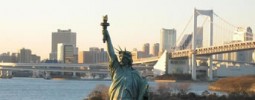Oruro is the capital city of the department Oruro in Bolivia, situated in between La Paz and Surce. The city was first founded in November, 1606 by Don Manuel Castro de Padilla. Oruro is a industrial city which manage to attract tourists with festivals and sightseeing’s such as the Carnival de Oruro. As of latest measurement the city of Oruro has a population of 420 thousand people.
The city of Oruro is a 5 hour bus ride away from La Paz, once you arrived you’ll notice the simplicity and well planned streets, which lead to the main square garden named Plaza 10 de Febrero. Of course, Oruro is known for it’s carnival, the famous sightseeing The Virgen del Socavon temple is where the carnival ends, during other seasons you can visit its mining museum. Other sightseeing’s include the zoo, several museums and churches, temples and chapels. Further more Oruro is a city fulfilled of legends and traditions, which locals love telling travelers about.
When you’re staying in the city for several days, take a walk up the hills surrounding Oruro, it’s an easy and nice excursion which offers unique and breathtaking views. Bring water and a digital camera along. Faro del Conchupata, according to locals is the best sightseeing in Oruro, which is a historical and cultural lighthouse on the top of the hills.
To visit Bolivia, you will need a valid passport and about a hundred dollars for the visa. You need to fill in a visa application form as well. You also need to submit proof of sufficient funds for your stay, proof of return travel, and, if coming from Brazil or Paraguay, a proof that you have had your yellow fever vaccination.
Tarija, also known as San Bernardo de la Frontera de Tarija is a city in southern Bolivia. It’s the capital and largest city within the Tarija Department, with it’s own airport (TJA) and a regional bus terminal with domestic and international destinations. The city has a Mediterranean climate similar to other Bolivian cities like Sucre, which is the complete opposite to the harsh cold in La Paz, and the heat in Santa Cruz. As of latest measurement the city of Tarija has a population of 200 thousand people.
Both travelers and local citizens agree, Tarija is the most Argentine city of Bolivia, there’s two ways to define it. It’s citizens are descended from Argentina, yet more importantly, it’s fabulous wine region. The city feels like the Argentina towns Jujuy and Salta, yet it has an exotic ambiance of Bolivian reality surrounding it, which you can feel taking a stroll in the central plaza or dining in one of the small yet fine restaurants serving both local and international cuisine. It’s advised to try an excellent local Argentinian wine Concepciòn, for a Bolivian price.
Another unique feature to this travel destination lies within it’s climate, vegetation, agriculture, locals and their language. If you enjoying your stay in Tarija, and wish to see more unique cities, towns you can follow the road to Argentina which goes through mountains and a deep forest canyon. Once you cross the border at Beremjo and Aguas Blancas you can continue the gringo trail leading deeper into Argentina towards Parque Nacional Calilegua, Salta, Jujuy and many other small villages where you hardly find any tourists.
To visit Bolivia, you will need a valid passport and about a hundred dollars for the visa. You need to fill in a visa application form as well. You also need to submit proof of sufficient funds for your stay, proof of return travel, and, if coming from Brazil or Paraguay, a proof that you have had your yellow fever vaccination.
Coroico is a town located in the Nor Yungas Province, in the La Paz Department of western Bolivia. The city was founded above the Kori Huayco River, meaning “Golden Valley” in Aymara. It has been build from the profits from mining gold back in 17th century. As of latest measurement the city of Coroico has a population of 30 thousand people.
The town of Coroico is a good place to spend a day before heading up to La Paz, or further into the Jungle. Because Coroico’s the lower elevation, the weather is quite nice by comparison to La Paz, and has a resort-like ambiance to it. Recently opened is the new highway to Coroico, which makes the town an easy access to point from other domestic destinations. For the adventurous traveler you make a trip from Coroico to La Paz on the so called “World Most Dangerous Road”.
The surrounding areas of Coroico are famous for hiking, many of the local travel agencies offer one day hikes where you can walk, climb and swim when seeing the local agriculture, old Casa da Hacienda which are the houses of former landowners, virgin forests and Afro-Bolivian communities. Another upcoming community is the eco tourism in the region, where local guides offer excursions the most beautiful valley with a fabulous cloud forest with monkeys jumping around, and as highlight the forgotten Inca Trail carved into the sheer canyon walls.
To visit Bolivia, you will need a valid passport and about a hundred dollars for the visa. You need to fill in a visa application form as well. You also need to submit proof of sufficient funds for your stay, proof of return travel, and, if coming from Brazil or Paraguay, a proof that you have had your yellow fever vaccination.
Sucre is the constitutional capital of Bolivia. The city is located in the south-central part of the country, on an altitude of 9,000 ft. Its lower altitude gives the city a warm temperate climate year-round. As of latest measurement the city has a population of population 260 thousand people.
The city of Sucre is famed throughout Bolivia, for it’s pretty en well maintained center, and it’s favorable climate, it’s locally known as “la ciudad blanca” or white city it’s often referred to as the most calm and relax in Bolivia, some say South America. Sucre sightseeing offers specific attractions in and around city center but also countryside such as historic theaters and museums like Casa de la Libertad, as well indigenous culture and prehistoric with as highlight Sucre’s relaxed atmosphere surrounded by them as earlier mentioned.
Getting around within city limits is easy, as Sucre is a small city with hop-on buses and private taxis. Some of the sightseeing on Sucre’s country side require private transport such as the Tarabuco market where the Cal Orkco dinosaur footprints are also located. Other than that, most travelers will stay within 5 blocks of the main square Plaza 25 de Mayo. To experience the relaxed ambiance of Sucre travel to Parque Bolivar a spacious park in the heart of the city.
To visit Bolivia, you will need a valid passport and about a hundred dollars for the visa. You need to fill in a visa application form as well. You also need to submit proof of sufficient funds for your stay, proof of return travel, and, if coming from Brazil or Paraguay, a proof that you have had your yellow fever vaccination.
Santa Cruz de la Sierra is the largest city in Bolivia and its business center. It is located in the east of the country. The name Santa Cruz de la Sierra means ‘Holy Cross of the Hills’ and was founded by a Spanish captain, who named the settlement after a city in Spain. Originally the city was located east of its modern location. Santa Cruz has a population of over 1.5 million people.
Many tourists think Santa Cruz is a city of business people and busy traffic. Although the city is the largest in the country, it hasn’t got a business feeling. It lacks high-rise blocks. The feeling is that of a lightly buzzing small-town, with a relaxed tropical atmosphere. The locals in the city lounge on the main square and restaurants still close for siesta. The restaurants will serve mostly traditional foods such as majao, locro and masaco.
The city’s lay-out shows three rings or anillos. Tourists can visit the Cathedral, the Central Park, many markets. The city has some museums, like the Museum of Holy Art and the Natural History Museum. There are some great excursions that you can book in Santa Cruz. You can go trekking in Park Amboro or Park Noel Kempff or take a boat trip over the Amazon River. You can relax at the lagoon at Park El Arenal, just don’t do this at night.
Travelers to Santa Cruz need a valid passport and get a visa application form that can be granted to you on arrival by plane. You also need to submit proof of sufficient funds for your stay, proof of return travel. You need a certification that you’ve had Yellow Fever before if you come from Brazil or Paraguay. Check the embassy in your country before you leave to get the right requirements. Be aware that no official police officer will ask to see your documentation on the streets of Santa Cruz. You should insist to accompany you to the police station.
If you love heights, visit La Paz in the South American country of Bolivia. Sucre may be the country’s judicial capital but La Paz, the largest city, is the business center and governmental capital. La Paz is situated 3.6 thousand meters above sea level. It is not all about its location, however. It also offers breathtaking views, thanks to buildings settled at the bottom of canyons. La Paz’s over a million inhabitants may continue to grow because of the influx of immigrants.
Quechua is spoken in La Paz, as well as Spanish. Quechua is a Native American dialect, which is an active sign of Bolivia’s having the strongest Native American population in all of South America. You can walk around La Paz to find more evidences of its rich culture through the city’s local comedors, modern cafes, and bustling markets. Museums will reveal more of La Paz’s roots. The city’s altitudes need a little getting used to, however. Streets where there are public demonstrations are evidences of the citizens’ political freedom.
You can get to La Paz via El Alto Airport. From the airport, you can ride a bus or a taxi requested via your reserved hotel. If you do not have hotel reservations, you may also ride a taxi from the airport. Within the city, you can get around by bus or taxi as well. You may save money by taking the train but it can be pretty slow. Walking is also a good idea when getting around La Paz. Make sure to bring the proper clothing, as temperatures can vary. Most of the times, you will experience cool or even freezing temperatures at night. April to October is the best season to visit La Paz.
To visit Bolivia, you will need a valid passport and over a hundred dollars for the visa. You need to accomplish a visa application form. You also need to submit proof of sufficient funds for your stay, proof of return travel, and, if coming from Brazil or Paraguay, a proof that you have had your yellow fever vaccination.








